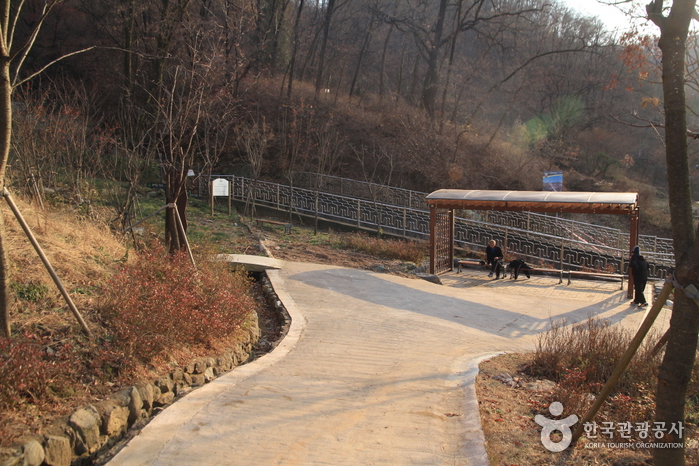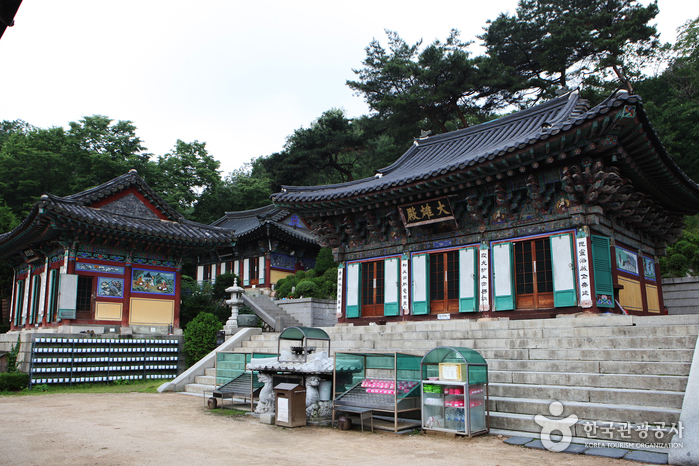Samgaksan Mountain (삼각산)
14.2Km 2024-03-20
Samyang-ro 173-gil, Gangbuk-gu, Seoul
Samgaksan Mountain is a mountain situated on the northern outskirts of Seoul, resembling a folding screen. Its name, meaning triangular mountain, is derived from the presence of three high peaks: Baegundae Peak, Insubong Peak, and Mangyeongdae Overlook. The highest peak, Baegundae Peak, offers a panoramic view of Seoul from its summit, featuring a spacious rock surface where many visitors can sit. Positioned behind Gyeongbokgung Palace, the palace of the Joseon dynasty, Samgaksan Mountain is visible from the rear of the Cheong Wa Dae.
Seoul Mangusan Mountain (망우산(서울))
14.2Km 2021-02-10
San 69-1, Mangu-dong, Jungnang-gu, Seoul
+82-2-2094-2395
Mangusan Mountain at 281.7 meters above sea level spans across Mangu-dong and Myeonmok-dong of Seoul, and Guri-si of Gyeonggi-do. Located on the mountain is Mangu Cemetery, which was designated as a public cemetery in 1933. Since its designation, many popular people have been buried here including children’s literature author Bang Jeong-hwan (penname: Sopa), independence activists Oh Se-chang and Han Yong-un, and Ji Seok-young who pioneered the use of the smallpox vaccination in Korea and was also a Korean linguist. In addition, tombstones bearing chronological listings of seven popular poets and one educator were installed at the park, making the cemetery a venue for historical education. The park also has Sin Gyeong-jin Sindobi, a cultural asset designated as Seoul Tangible Cultural Property No. 95. It is a monument of Sin Gyeong-jin, an official scholar of the Joseon dynasty.
The park also has a 5.2-kilometer-long circular road named “The Thinking Path”. The name was selected through a public competition held in May 1998. Other facilities include the urban environment and nature observation road, a wooden gazebo, and a mineral spring. Thanks to the well managed trees and clean air, the park is visited by many citizens seeking a place to rest.
GREEN CHICKEN DOCTOR (그린치킨닥터)
14.3Km 2021-03-26
8, Sinimun-ro 28-gil, Dongdaemun-gu, Seoul
+82-2-966-2732
It’s a store whose low-priced meals are popular among college students. This Western dishes restaurant is located in Dongdaemun-gu, Seoul. The representative menu is chicken steak.
Olive Young - Guri Sutaek Branch [Tax Refund Shop] (올리브영 구리수택점)
14.3Km 2024-06-27
70, Imunan-ro, Guri-si, Gyeonggi-do
-
E-Mart - Pocheon Branch [Tax Refund Shop] (이마트 포천)
14.4Km 2024-04-22
915, Hoguk-ro, Pocheon-si, Gyeonggi-do
-
Uireung Royal Tomb [UNESCO World Heritage] (서울 의릉(경종, 선의왕후) [유네스코 세계문화유산])
14.5Km 2021-06-03
146-20, Hwarang-ro 32-gil, Seongbuk-gu, Seoul
+82-2-964-0579
Uireung is the royal tomb of King Gyeongjong (reign 1720-1724), the 20th ruler of the Joseon dynasty, and his second wife, Queen Seonui.
King Gyeongjong was the first son of King Sukjong and Janghuibin, who was one of King Sukjong’s concubines. King Gyeongjong, who was born weak and anemic, died four years after becoming the king, without any great political achievements. Uireung tombs differ from the other royal double tombs in that they are not placed side-by-side. Instead, according to geomantic theory, one tomb has been placed directly behind the other one. The arrangement also shows that when making tombs, Korean ancestors did their best to protect the natural environment. Another feature of Uireung Royal Tomb is the stone fence raised using twelve stone posts. Each post has a letter inscribed, representing one of the twelve sibijisin gods.
Lotte Mart - Samyang Branch [Tax Refund Shop] (롯데마트 삼양점)
14.5Km 2024-04-22
247, Samyang-ro, Gangbuk-gu, Seoul
-
Seoul Hwagyesa Temple (화계사(서울))
14.7Km 2021-11-02
117, Hwagyesa-gil, Gangbuk-gu, Seoul
+82-2-902-2663
Hwagyesa Temple was built in 1522 (the seventeenth year of the reign of King Jungjong of the Joseon dynasty) by monk Shinwol, but was destroyed in a fire in 1618. It was rebuilt the following year, and expanded In 1866 through the efforts of Monks Yongseon and Beomun.
The temple also has various templestay programs for visitors. Hwagyesa Temple is located not too far from the city but also provides a natural environment.
Uniqlo - Namyangju Hwado Branch [Tax Refund Shop] (유니클로 남양주화도)
14.7Km 2024-06-26
1637, Gyeongchun-ro, Hwado-eup, Namyangju-si, Gyeonggi-do
-
Olive Young - Namyangju Hwado Branch [Tax Refund Shop] (올리브영 남양주화도점)
14.7Km 2024-06-27
1637, Gyeongchun-ro, Hwado-eup, Namyangju-si, Gyeonggi-do
-


![E-Mart - Pocheon Branch [Tax Refund Shop] (이마트 포천)](http://tong.visitkorea.or.kr/cms/resource/63/2881263_image2_1.jpg)
![Uireung Royal Tomb [UNESCO World Heritage] (서울 의릉(경종, 선의왕후) [유네스코 세계문화유산])](http://tong.visitkorea.or.kr/cms/resource/80/2690680_image2_1.jpg)
![Lotte Mart - Samyang Branch [Tax Refund Shop] (롯데마트 삼양점)](http://tong.visitkorea.or.kr/cms/resource/54/2887854_image2_1.jpg)

![Uniqlo - Namyangju Hwado Branch [Tax Refund Shop] (유니클로 남양주화도)](http://tong.visitkorea.or.kr/cms/resource/96/3313296_image2_1.jpg)
 English
English
 한국어
한국어 日本語
日本語 中文(简体)
中文(简体) Deutsch
Deutsch Français
Français Español
Español Русский
Русский